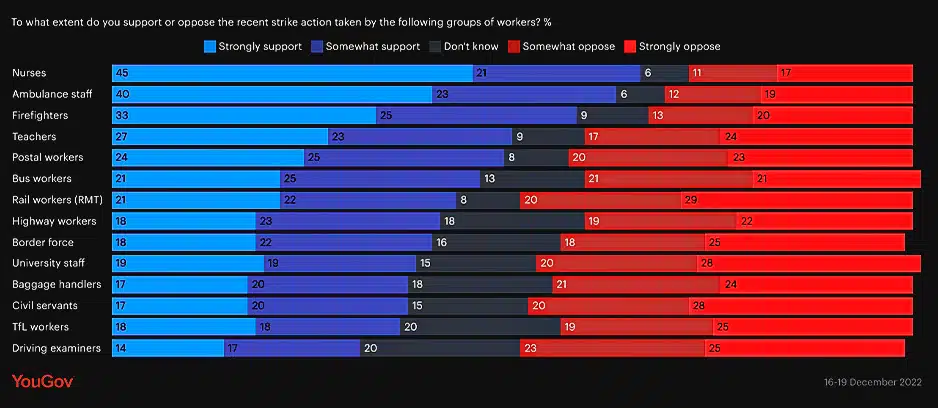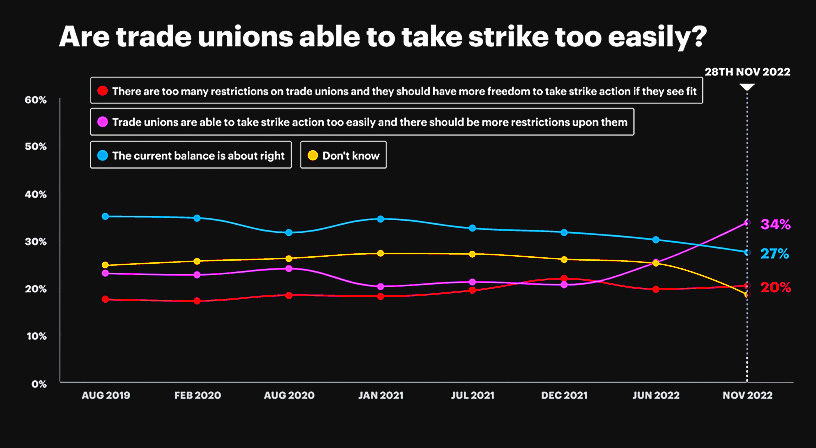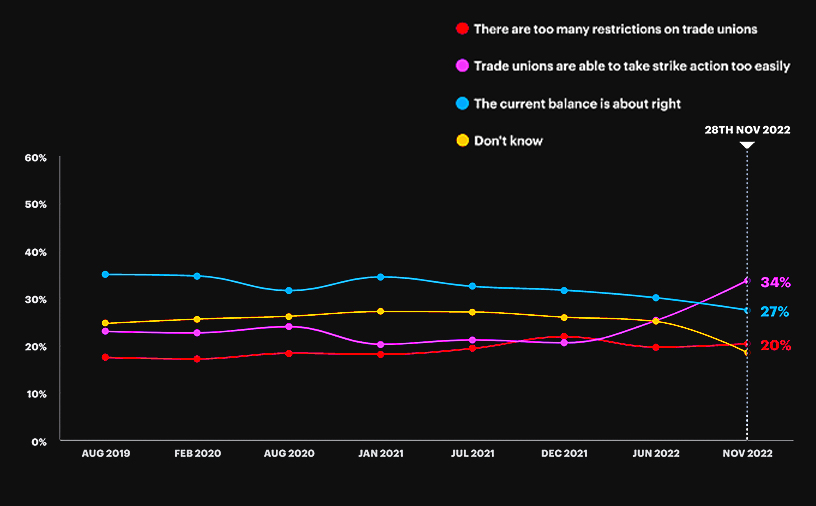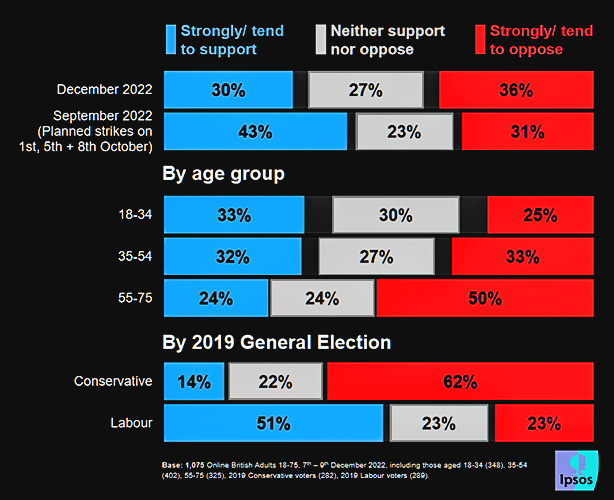
Unwrapping the numbers: Young men support the strikes the most, but unions are losing public backing
FACT-CHECK GUARANTEE (References): [Official statistics: 5 sources]
| By Richard Ahern — Posties, rail workers, teachers, nurses, medics, and the list goes on as more industries get hit with strike action across the United Kingdom.
One of the first significant strikes began in August 2022, when over 100,000 postal workers took 18 days of strike action strategically spread across the months before Christmas. As a result, the United Kingdom saw massive disruption to Christmas deliveries, with the last strike of the year taking place on Christmas Eve.
Since then, only more industries have joined them. The largest disruption in the new year has been from NHS workers, including nurses and ambulance staff. The public has been warned of substantial delays when dialing 999 for medical emergencies and to do so only for “life and limb” emergencies.
Nurses have called the largest strike in the history of the NHS, resulting in an already strained health system coming to a standstill.
The British people are suffering the consequences, but have they had enough? Or do they stand with the unions against the government and corporations?
Let’s unwrap the data …

Perhaps surprisingly, the strikes that are the most frightening and significant to the public are the ones that currently have the most robust backing.
Before the unions gained steam, polls taken in June 2022 indicated the public had the most sympathy for nurses, doctors, and firefighters and the least for university staff, civil servants, and barristers.
Those opinions still hold today …
The most recent data collected by YouGov on 20 December 2022 clearly shows that the public overwhelmingly supports nurses, ambulance staff, and firefighters striking above every other industry. Nurses hold the top spot with 66% of the people behind them; ambulance staff come in second with 63% support, and firefighters behind them at 58%.
Teachers and postal workers also have good backing, with around 50% of the public behind them.
Life-saving workers have the most sturdy backing from the public, despite the consequences the strikes could bring.
Going down the list, the public shows the least support for civil servants, Transport for London workers, and driving examiners, according to YouGov data from December.


The bigger picture
The bigger picture is slightly different and shows the public may be growing tired of the disruption caused by unions. In the latter half of 2022, there was a significant uptick in people who said trade unions can strike “too easily” and restrictions should be placed upon them.
In June 2022, 25% of the population believed unions could strike “too easily” — that figure jumped to 34% in November 2022.
Data collected by Ipsos also shows the growing fatigue from the public. When questioned about the power balance between employers, workers, and trade unions, from June to December 2022, the public’s perception of the power balance shifted rapidly. In June and September, approximately 30% said trade unions have “too little” power, but that figure fell to 19% in December. Similarly, 61% said workers had “too little” power in June, but that figure dropped to 47% in December.
Data on public support for the rail strikes showed that people have the most sympathy for railway passengers (85%). 61% also had sympathy for railway workers — but there was a 4% decrease in that number from September to December, again showing a growing frustration with the disruption.
Who supports the strikes?
Digging deeper, there is a clear demographic of the population who supports unions. Unions have the most support from the younger generation.
We’ve taken the average total support for all industry strikes from December 2022 data. The average total support for all unions among 18 – 49 year-olds was 53.5%, compared to a much smaller 38.8% of those over 50 who support strikes.

Ipsos found that when asked about the rail strikes, 50% of 55 – 75 year-olds opposed the strikes compared to only 25% of 18 – 34 year-olds.
And politically, the data is unsurprising …
Overwhelmingly, unions have the most support from people who voted for Labour in the 2019 general election. Take nurses who hold the top spot for public support — 87% of Labour voters are behind them compared to only 49% of Conservative voters. Across all industries, that trend is clear.
Even for driving examiners, who scored the lowest with the public in December — over half (55%) of Labour voters still support strike action compared to a minuscule 13% of Conservative voters. Similarly, Liberal Democrat voters generally support unions but less so than Labour voters.
What about men vs. women?
Gender appears to have less of an effect on support for unions. Still, men often show slightly more tolerance for strike action than women. More men (67%) support nurses going on strike compared to 65% of women. Likewise, with ambulance workers, we see 65% of men behind the union compared to 62% of women.
The male-to-female gap is wider for industries such as highway workers (44% male, 36% female) and baggage handlers (42% male, 33% female).
In fact, for every industry surveyed, men support strike action more than women. However, it’s important to note that, on average, the female population takes a more neutral stance, with more voting “don’t know” in many cases.
In a nutshell
- NHS and emergency services workers have the most public support.
- Civil servants, Transport for London workers, and driving examiners have the weakest backing from the public.
- The opinion that trade unions can strike “too easily” increased by 9% in the latter half of 2022.
- The belief that workers need more power decreased from 61% to 47% from June to December 2022.
- On average, 53.5% of 18 – 49 year-olds support workers striking, compared to 38.8% of people over 50.
- Labour voters support trade unions the most.
- Men support trade unions more than women by a small margin.
The take-home message?
NHS and emergency workers have the strongest backing from the public, and that support is growing. Yet, overall, the public is growing increasingly concerned about unions having too much freedom to strike. In particular, support for rail workers saw a sharp decline towards the end of last year.
And statistically, the strongest supporter of strike action is a young (18 – 49), Labour-voting male. So although gender is the least significant differentiator, it is clear that young Labour voters are firmly in support of strike action, but older conservative voters want to see workers back on the job.
Have an opinion? Do you support the strike action? Comment below!
We need YOUR help! We bring you the uncensored news for FREE, but we can only do this thanks to the support of loyal readers just like YOU! If you believe in free speech and enjoy real news, please consider supporting our mission by becoming a patron or by making a one-off donation here. 20% of ALL funds are donated to veterans!
This article is only possible thanks to our sponsors and patrons!

Join the discussion!